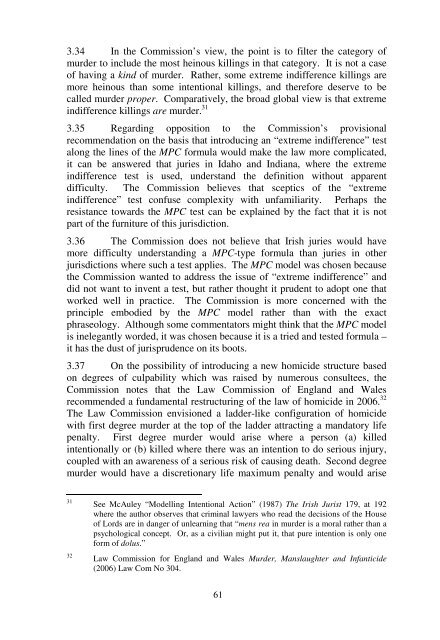murder and involuntary manslaughter - Law Reform Commission
murder and involuntary manslaughter - Law Reform Commission
murder and involuntary manslaughter - Law Reform Commission
You also want an ePaper? Increase the reach of your titles
YUMPU automatically turns print PDFs into web optimized ePapers that Google loves.
3.34 In the <strong>Commission</strong>’s view, the point is to filter the category of<strong>murder</strong> to include the most heinous killings in that category. It is not a caseof having a kind of <strong>murder</strong>. Rather, some extreme indifference killings aremore heinous than some intentional killings, <strong>and</strong> therefore deserve to becalled <strong>murder</strong> proper. Comparatively, the broad global view is that extremeindifference killings are <strong>murder</strong>. 313.35 Regarding opposition to the <strong>Commission</strong>’s provisionalrecommendation on the basis that introducing an “extreme indifference” testalong the lines of the MPC formula would make the law more complicated,it can be answered that juries in Idaho <strong>and</strong> Indiana, where the extremeindifference test is used, underst<strong>and</strong> the definition without apparentdifficulty. The <strong>Commission</strong> believes that sceptics of the “extremeindifference” test confuse complexity with unfamiliarity. Perhaps theresistance towards the MPC test can be explained by the fact that it is notpart of the furniture of this jurisdiction.3.36 The <strong>Commission</strong> does not believe that Irish juries would havemore difficulty underst<strong>and</strong>ing a MPC-type formula than juries in otherjurisdictions where such a test applies. The MPC model was chosen becausethe <strong>Commission</strong> wanted to address the issue of “extreme indifference” <strong>and</strong>did not want to invent a test, but rather thought it prudent to adopt one thatworked well in practice. The <strong>Commission</strong> is more concerned with theprinciple embodied by the MPC model rather than with the exactphraseology. Although some commentators might think that the MPC modelis inelegantly worded, it was chosen because it is a tried <strong>and</strong> tested formula –it has the dust of jurisprudence on its boots.3.37 On the possibility of introducing a new homicide structure basedon degrees of culpability which was raised by numerous consultees, the<strong>Commission</strong> notes that the <strong>Law</strong> <strong>Commission</strong> of Engl<strong>and</strong> <strong>and</strong> Walesrecommended a fundamental restructuring of the law of homicide in 2006. 32The <strong>Law</strong> <strong>Commission</strong> envisioned a ladder-like configuration of homicidewith first degree <strong>murder</strong> at the top of the ladder attracting a m<strong>and</strong>atory lifepenalty. First degree <strong>murder</strong> would arise where a person (a) killedintentionally or (b) killed where there was an intention to do serious injury,coupled with an awareness of a serious risk of causing death. Second degree<strong>murder</strong> would have a discretionary life maximum penalty <strong>and</strong> would arise3132See McAuley “Modelling Intentional Action” (1987) The Irish Jurist 179, at 192where the author observes that criminal lawyers who read the decisions of the Houseof Lords are in danger of unlearning that “mens rea in <strong>murder</strong> is a moral rather than apsychological concept. Or, as a civilian might put it, that pure intention is only oneform of dolus.”<strong>Law</strong> <strong>Commission</strong> for Engl<strong>and</strong> <strong>and</strong> Wales Murder, Manslaughter <strong>and</strong> Infanticide(2006) <strong>Law</strong> Com No 304.61
















